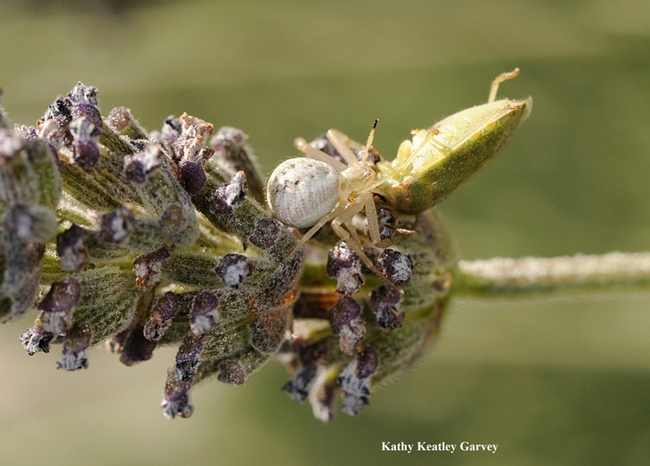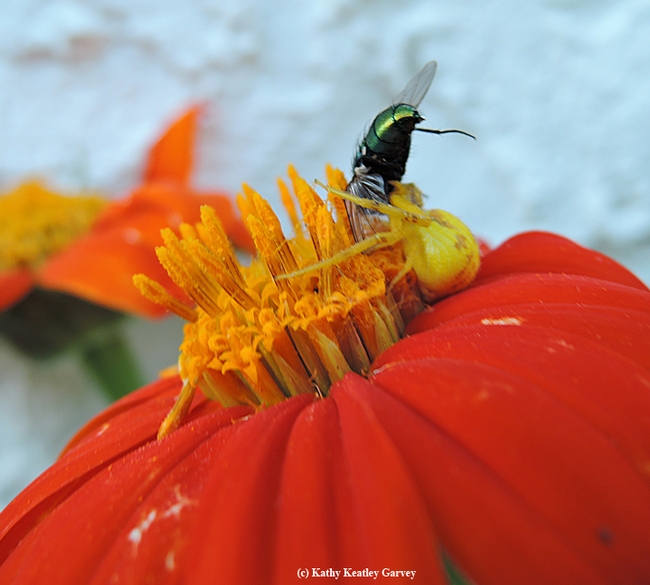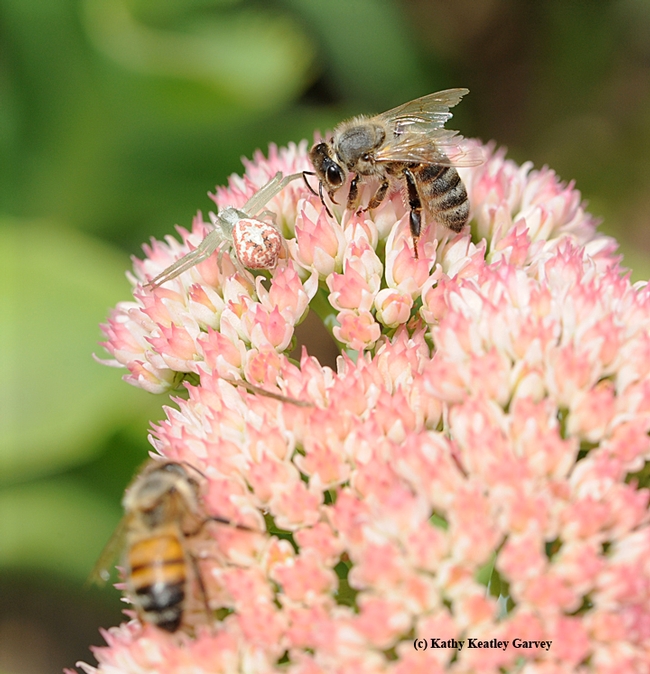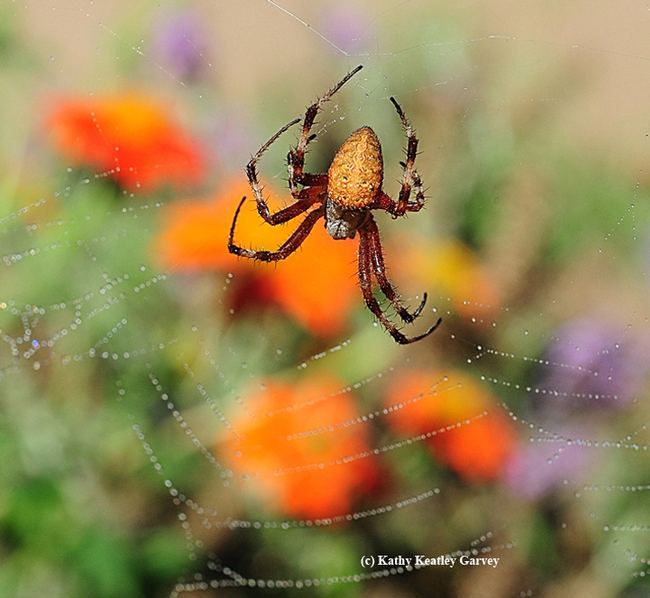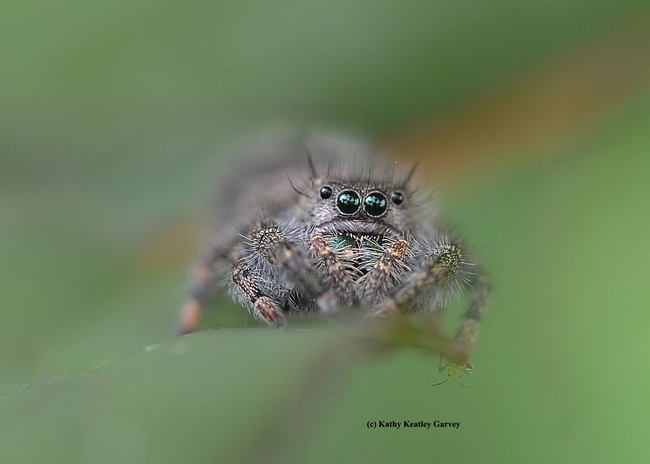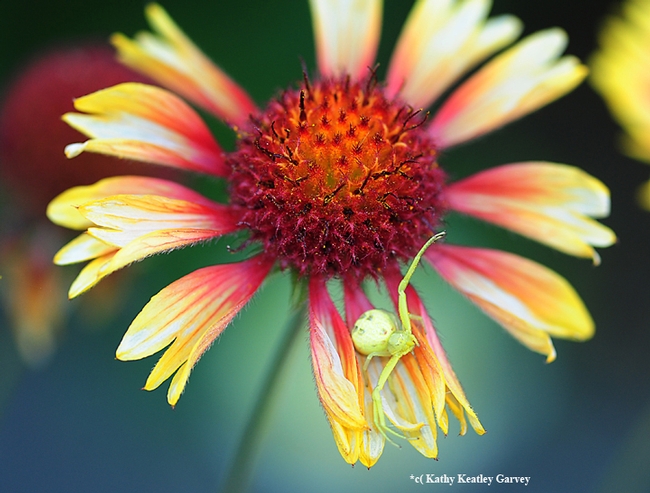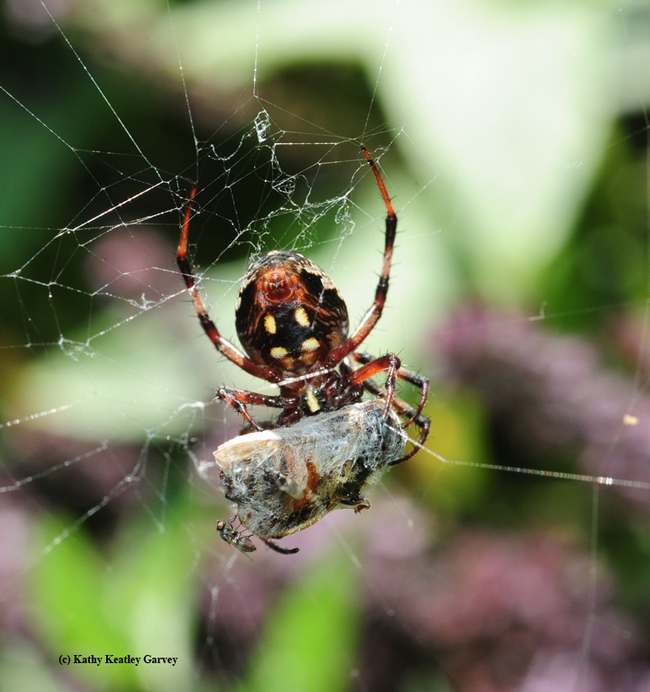- Author: Kathy Keatley Garvey
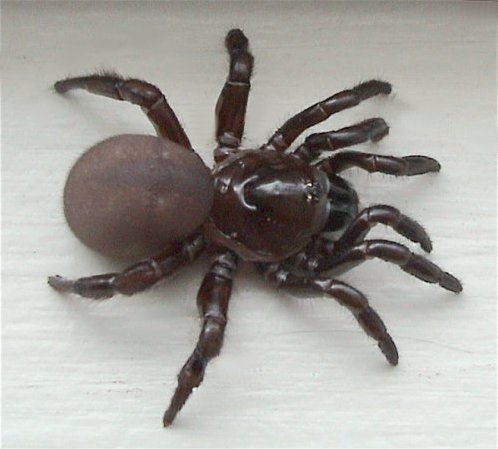
Two doctoral students from the Jason Bond laboratory, UC Davis Department of Entomology and Nematology, won first- and second-place awards in the student research competitions at the recent meeting of the American Arachnological Society, held at Washington and Lee University, Lexington, Va.
Rebecca Godwin won first in the poster competition for her research on trapdoor spiders and Lacie Newton won second for her oral presentation on species delimitation.
Congratulations to these dedicated doctoral students!
Godwin titled her work, “Revision of New World Ummidia (Mygalomorphae, Halonoproctidae)”: Her abstract: “Ummidia is a historically taxonomically difficult group of spiders belonging to the infraorder Mygalomorphae, one of the three main lineages recognized within spiders. Mygalomorph life history and their incredibly cryptic appearance make them difficult to identify, as a result they are frequently overlooked by spider systematists. Ummidia Thorell 1875 is a wide-ranging genus of trapdoor spider found both in the Mediterranean region of the Old World and in the New World from the eastern United States south to Brazil. Taxonomic work on New World Ummidia is sparse outside of original descriptions, the most recent of which are over half a century old."
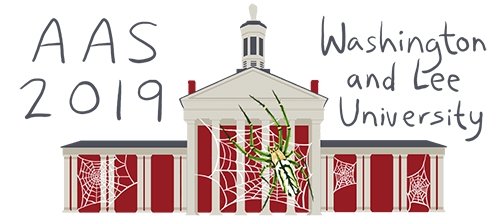
Lacie titled her work, “Species Delimitation of the Antrodiaetus Unicolor Species Complex Using a 3RAD Approach.” Her abstract: “Although species delimitation can be highly contentious, the development of reliable methods to accurately ascertain species boundaries is a fundamental and necessary step in cataloguing and describing Earth's quickly disappearing biodiversity. Species delimitation in spider taxa has historically been based on morphological characters; however, certain mygalomorphs are morphologically indistinguishable from each other yet have considerable molecular divergence."
"Previous research by Hendrixson and Bond (2005) described a new sympatric species Antrodiaetus microunicolor in the A. unicolor species complex using morphological criteria (i.e. size and setal character differences) and behavioral criteria (non-overlapping mating seasons). Subsequently, they used two molecular markers COI and 28S and discovered that A. unicolor is paraphyletic with respect to A. microunicolor. To further delineate this species complex, we implement the cohesion species concept and employ multiple lines of evidence for testing genetic exchangeability and ecological interchangeability. Our integrative approach includes extensively sampling homologous loci across the genome using a version of RADseq called 3RAD, assessing population structure across their geographic range, and evaluating ecological similarity by niche-based distribution modeling. Based on our analyses, we conclude that this species complex has two or three species in addition to A. microunicolor.”
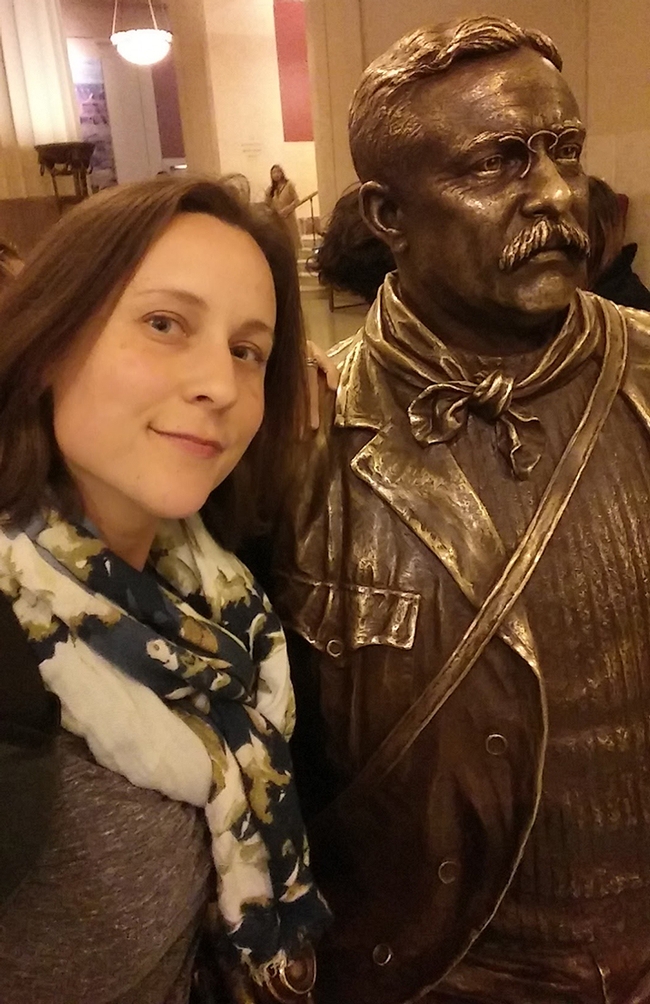
Godwin holds two degrees from Auburn University: her bachelor's degree in zoology in 2004, and her master's degree in wetland biology in 2011. She began her doctoral studies at Auburn University in 2014, and transferred to UC Davis when Bond accepted the UC Davis position in 2018.
Godwin won the Auburn University's Department of Biological Science's Outstanding Service Award in 2016. She is the lead author of research published in 2018 in the journal Molecular Phylogenetics and Evolution on “Phylogeny of a Cosmopolitan Family of Morphologically Conserved Trapdoor spiders (Mygalomorphae, Ctenizidae) Using Anchored Hybrid Enrichment, with a Description of the Family, Halonoproctidae Pocock 1901.” She currently serves as a graduate teaching assistant in the course, "Biology 2C," at UC Davis.
Godwin's research interests include taxonomy, systematics, and phylogreography of trapdoor spiders, as well as effective science communication and increasing general science literacy.
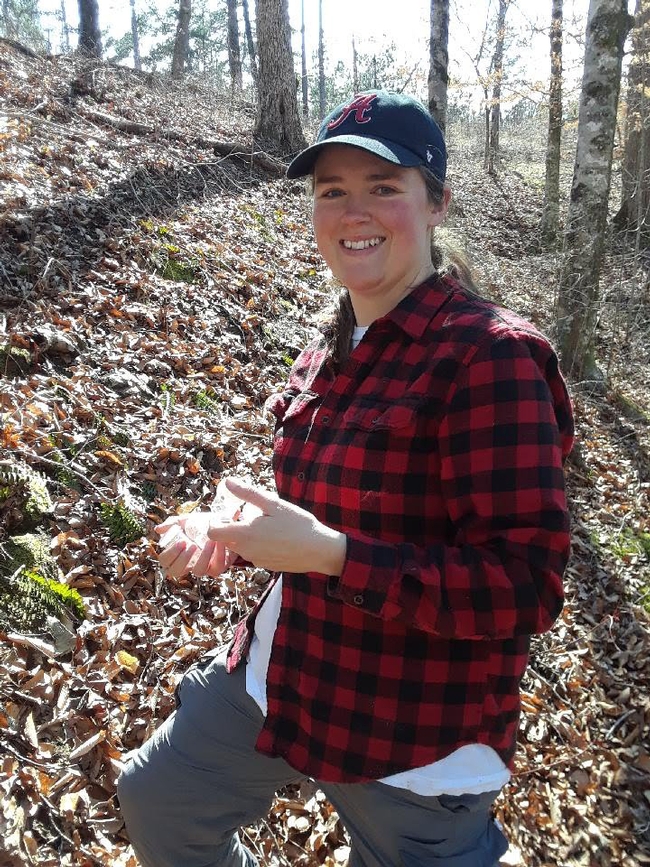
Newton received her bachelor of science degree from Millsaps College, Jackson, Miss., in 2016, and then joined the Auburn University doctoral program. Like Godwin, she transferred to UC Davis with her major professor in 2018. Newton served as an undergraduate teaching assistant at Millsaps College for “Introduction to Cell Biology” and “General Zoology,” and as a graduate teaching assistant in “Introduction to Biology” at Auburn University.
Newton now serves as a graduate teaching assistant at UC Davis for “Introduction to Biology: Biodiversity and the Tree of Life.” She won the 2019-2020 George H. Vansell Scholarship, UC Davis. Her research interests include systematics, species delimitation, and phylogeography of spiders; phylogenetics; comparative transcriptomics of troglophilic and troglobitic spiders; cave biology and conservation.
Both Godwin and Newton volunteer at the Bohart Museum of Entomology's programs on spiders and at the campuswide UC Davis Biodiversity Museum Day.
Bond joined the UC Davis faculty after a seven-year academic career at Auburn University, Ala. He served as professor of biology and chair of the Department of Biological Sciences from January 2016 to July 2018, and as curator of arachnids and myriapods (centipedes, millipedes, and related animals) at the Auburn University Museum of Natural History, from August 2011 to July 2018.
- Author: Kathy Keatley Garvey
What's for dinner?
A crab spider, camouflaged in our lavender patch, didn't catch a honey bee, a butterfly, an ant or a syrphid fly.
No, it nailed a green bottle fly.
We couldn't help but notice. The fly's metallic blue-green coloring stood in sharp contrast to the white spider.
One venomous bite to kill it. And soon the fly, Lucilia sericata, was toast. Milk toast.
Crab spiders don't build webs to trap their prey. They're cunning and agile hunters that spring into action when an unsuspecting prey appears on the scene. They belong to the family Thomisidae, which includes some 175 genera and more than 2100 species. And they're ancient: spiders date back 400 million years ago.
Do you like spiders? You should.
“Spiders are an incredibly diverse group with more than 50,000 species described with probably another 200,000 remaining to yet be discovered,” says spider expert Jason Bond, the Evert and Marion Schlinger Endowed Chair in Insect Systematics in the UC Davis Department of Entomology and Nematology.
It's worth repeating what Professor Bond said about spiders at the Bohart Museum of Entomology open house, “Eight-Legged Wonders,” on Saturday, March 9.
The five good reasons to like spiders:
- Spiders consume 400-800 million tons of prey, mostly insects, each year. Humans consume somewhere around 400 million tons of meat and fish each year.
- Spider silk is one of the strongest naturally occurring materials. Spider silk is stronger than steel, stronger and more stretchy than Kevlar; a pencil thick strand of spider silk could be used to stop a Boeing 747 in flight.
- Some spiders are incredibly fast – able to run up to 70 body lengths per second (10X faster than Usain Bolt).
- Athough nearly all 47,000-plus spider species have venom used to kill their insect prey, very few actually have venom that is harmful to humans.
- Some spiders are really good parents –wolf spider moms carry their young on their backs until they are ready to strike out on their own; female trapdoor spiders keep their broods safe inside their burrows often longer than one year, and some female jumping spiders even nurse their spiderlings with a protein rich substance comparable to milk.

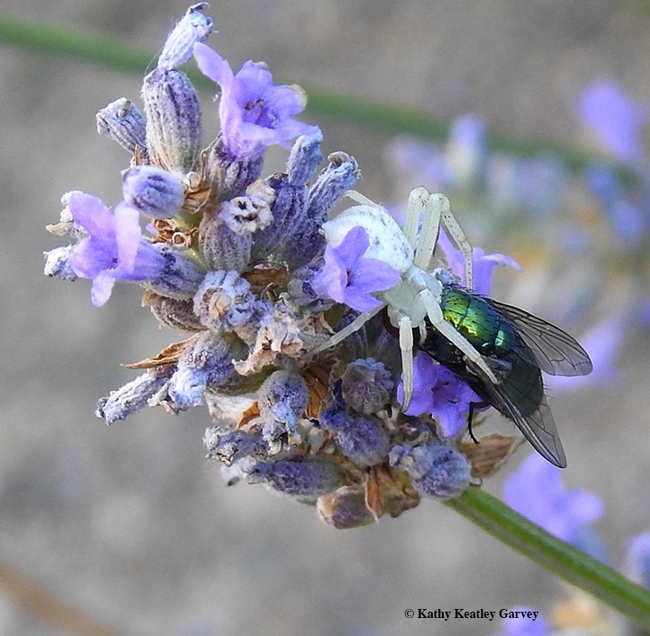
- Author: Kathy Keatley Garvey
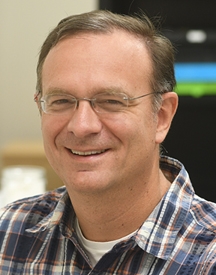
Have you ever wondered about sexual size dimorphism in the tropical spiders, the golden orbweavers?
The females are sometimes 10 times larger and 100 times heavier than their male counterparts. And the webs that the females weave are huge--they can be as wide as five feet in diameter.
And, yes, the females cannibalize the males, says Jason Bond, professor and Schlinger Chair in Insect Systematics, UC Davis Department of Entomology and Nematology,
“Sexual size dimorphism (SSD) often seems to be correlated with extreme morphological, behavioral and life history phenotypes in either sex,” says Bond, senior author of a newly published paper in the Journal of Systematic Biology, a peer-reviewed scientific journal published by Oxford University Press on behalf of the Society of Systematic Biologists.
Through phylogenomic (the intersection of the fields of evolution and genomics) and comparative analyses, Bond and his colleagues found that golden orbweavers “ignore biological rules.”
The global team of 11 scientists--from Slovenia, China, Taiwan, Czech Republic and the United States (UC Davis, Smithsonian Institution, University of Idaho, University of Florida and University of Vermont)--unraveled a complex evolution of sexual size and dimorphism and found that Nephilid female gigantism is a “phylogenetically ancient phenotype, over 100 million years old, though their magnitudes vary by lineage.”
The spiders belong to the genus Nephila and family Nephilidae; the members are known for constructing huge or exaggerated webs. The species thrive in warmer regions throughout the world, including Australia, Asia, Africa (including Madagascar) and the America. One species, N. clavipes, is found in southern United States, from Texas to North Carolina.
For the paper, “Golden Orbweavers Ignore Biological Rules: Phylogenomic and Comparative Analyses Unravel a Complex Evolution of Sexual Size Dimorphism,” the team tested two biological rules: Cope's rule and Rensch's rule. Cope's rule postulates that population lineages tend to increase in body size over evolutionary time. Rensch's rule is a biological rule on allometric patterns of male and female size. Neither rule applied to the golden orbweavers.
First, the scientists established the backbone phylogeny of Nephilidae, using 367 anchored hybrid enrichment markers, and then combined these data with classical markers for a reference species level phylogeny.
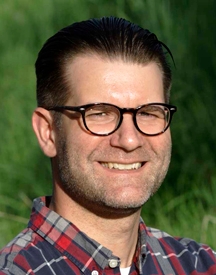
In conclusion, the scientists proposed a new clade, a group of organisms evolving from a common ancestor. They resurrected the family Nephilidae and proposed the new clade, Orbipurae, to contain Araneidae Clerck 1757, Phonognathidae Simon 1894, new rank, and Nephilidae.
The researchers proposed “taxonomic changes based on the criteria of clade age, monophyly and exclusivity, classification information content, and diagnosability. Spider families, as currently defined, tend to be between 37 million years old and 98 million years old, and Nephilidae is estimated at 133 million years old, thus deserving family status.”
“Nephilid female gigantism is a phylogenetically ancient phenotype (over 100 million years old), as is extreme sexual size dimorphism, though their magnitudes vary by lineage,” they wrote. “Despite the sometimes conflicting trends seen within Nephilidae, the clade stands as the most extreme example of female-biased SSD among terrestrial animals, as far as we know.”
The Jason Bond lab and the Chris Hamilton lab, Department of Entomology, Plant Pathology and Nematology at the University of Idaho, Moscow, provided the anchored hybrid enrichment data and phylogenomic analysis.
Co-authors of the paper, in addition to Bond and Hamilton, are
- Matjaž Kuntner of the National Institute of Biology, Ljubljana, Slovenia; the National Museum of Natural History, Smithsonian Institution, Washington D.C.; and Hubei University, China;
- Ren-Chung Cheng, Biological Institute ZRC SAZU, Ljubljana, Slovenia, and National Chung Hsing University, Taiwan;
- Matjaž Gregorič, Nik Lupše and Tjaša Lokovšek, all with the Biological Institute ZRC SAZU, Ljubljana,Slovenia (Lupse is also affiliated with the Charles University, Prague, Czech Republic);
- Emily Moriatry Lemmon and Alan Lemmon, Florida State University, Tallahassee;
- Ingi Agnarsson of the National Museum of Natural History, Smithsonian Institution; and University of Vermont, Burlington; and
- Jonathan Coddington, National Museum of Natural History, Smithsonian Institution.
The research drew funds from Slovenian Research Agency grants, from the U.S. State Department through a Fulbright visiting scholar; ZRZ Director's Fund, National Science Foundation, Doctoral Dissertation Improvement Grant and funds from Auburn University, Alabama. Bond joined the UC Davis faculty in July of 2018 from Auburn University after a seven-year academic career there, where he served as professor of biology and chaired the Department of Biological Sciences. He also curated the arachnids and myriapods (centipedes, millipedes, and related animals) at the Auburn University Museum of Natural History.
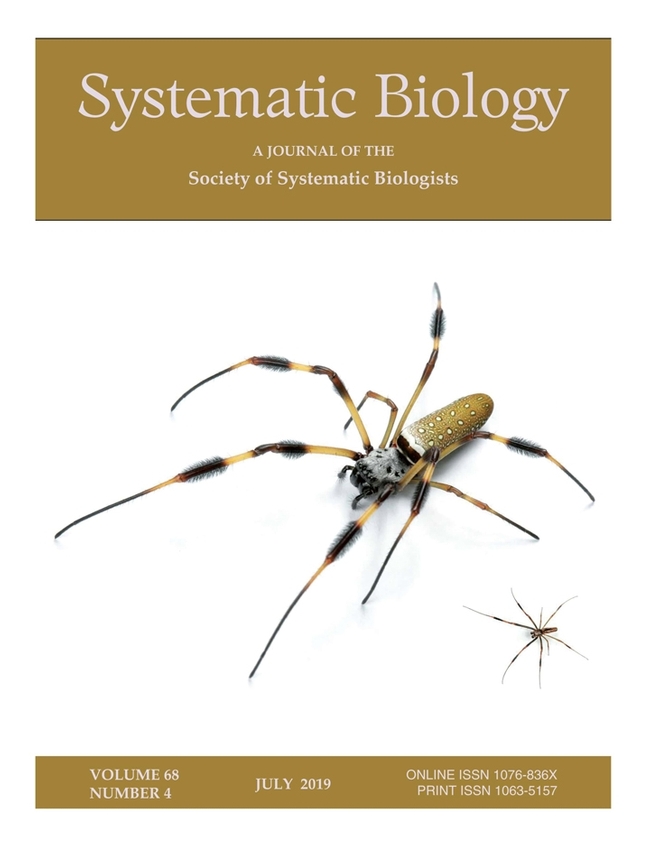
- Author: Kathy Keatley Garvey
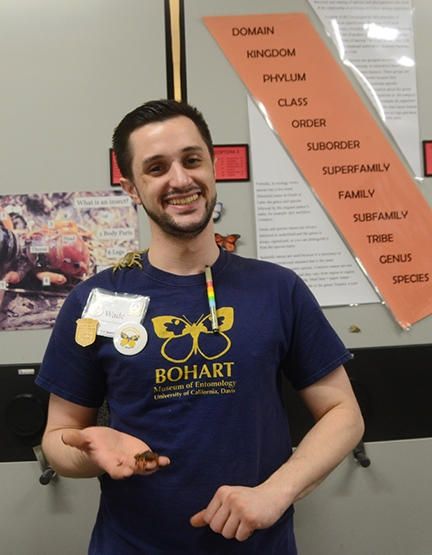
Logan, a visitor at the Bohart Museum of Entomology's recent open house on spiders and other arachnids, wowed the crowd with his knowledge of scorpions.
“Logan is only in kindergarten but he was showing his mom our arachnid drawer and describing the differences between the Emperor Scorpion, Pandinus imperator, and the Dictator Scorpion, Pandinus dictator,” said Bohart associate and scorpion scientist Wade Spencer, an undergraduate student at Bohart Museum. “Thankfully, he wasn't at all shy when I asked him to repeat what he had just said to the crowd.”
“He loved sharing his knowledge with those interested,” Spencer said. “And his mom is an arachnid saint as she supports his endeavors even while she still gets the willies from just looking at them. She told me she finds it important to keep her cool so that he may never lose his enthusiasm.”
The Bohart Museum's three-hour open house included a presentation on spiders by Jason Bond, the Evert and Marion Schlinger Endowed Chair in Insect Systematics, UC Davis Department of Entomology and Nematology. Scientists in both the Bond lab and the Bohart lab led arachnid activities, including "Eat Like a Spider" and "Catch a Moth."
Spencer and fellow Bohart associate and entomology undergraduate student Lohit Garikipati, tabled the scorpion display. The guests asked questions, gingerly touched them, and took cell phone photos.
Spencer currently has 37 scorpions of various species. Scorpions are venomous, not poisonous, he pointed out. As Professor Bond said in his talk: "Poisonous is what you eat it make you sick. Venomous means it takes toxin and it injects it into you."
"Fun fact about scorpions, Spencer said, "is that all of them are safe to eat as none of them are poisonous (toxins ingested or absorbed), but all of them (as far as we know) are venomous (containing poison(s) which are injected by some means)."
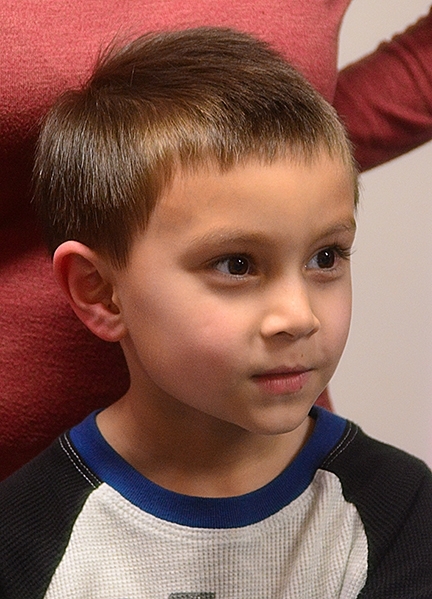
"I use the term 'medically significant' because it has the most potent venoms we know of, but I refrain and even discourage the use of the term 'dangerous' when describing scorpions and other venomous creatures," Spencer said. "It's often our own carelessness which makes them dangerous. If you live in in scorpion country, shake out your boots if you leave them outside and buy a $20 UV flashlight on Amazon. Those are simple ways to detect them and avoid being stung."
Spencer said he handles "my little Leiurus q. to show just how gentle and adorable she is so that people can have visual confirmation to back my claim that there is no such thing as a dangerous scorpion--though it should be clear I am not saying they're cuddly or friendly like a puppy. I advocate for them to be treated with caution and respect.
The UC Davis student attributes his interest in scorpions to his great-grandmother.
"My great-grandmother would always take me on afternoon picnics in the Big Tujunga Canyon Wash, a mostly dry river bed in the San Gabriel mountains in my home town of Sunland. She was a naturalist at heart and taught me about the native plants, geology, birds, mammals, reptiles, amphibians, and my favorite: the bugs. If ever we encountered a scorpion, she would stop and show me, but wouldn't kill them. Instead, starting when I was 3, she taught me that they were nothing to fear and showed me how to gently handle them. I've handled thousands ever since and not once been stung."
"I'm often asked why I'm not stung, and my response is always the same: 'It's not a cat!' By that, I mean, there's no risk of it randomly attacking me. I have scars all over my body from dogs and cats."
Spencer loves scorpions for three primary reasons:
- "Knowing their ancestors were the first animals on land about 450 million years ago."
- "Many of their venoms are being studied for use in shrinking brain tumors, sending fluorescent dyes to tumors with such specificities as to view 200 cancerous cell clusters--whereas MRIs can view 500,000 cell clusters. And some--to regulate insulin, treat arthritis, and antimicrobial components--have been used in mice with MRSA (methicillin resistant Staphylococcus aureas), completely curing them in 4 days."
- "Working with them directly and seeing how many people we have helped get over their fears has me simply head-over-heels for them."
The scorpion display drew the interest of adults and children alike. Three Brownie Girl Scouts from Vacaville giggled and comforted one another when they experienced the "Virtual Reality Spiders" demonstration conducted by medical entomologist Geoffrey Attardo, assistant professor, UC Davis Department of Entomology and Nematology. But not so the scorpion display.
"When it came to the live stuff, the girls (Kendl Macklin, 7, Jayda Navarette, 8, and Keira Yu, 8) were more calm than nervous," said Spencer, adding "I thanked them for their bravery and showing the adults that there was nothing to fear."
The Bohart Museum, directed by Lynn Kimsey, UC Davis professor of entomology, is located in Room 1124 of the Academic Surge Building on Crocker Lane. It houses nearly 8 million insect specimens, a gift shop, and a live "petting zoo" of Madagascar hissing cockroaches, stick insects or walking sticks, and tarantulas. The insect museum is open to the public Monday through Thursday, from 9 a.m. to noon, and from 1 to 5 p.m.
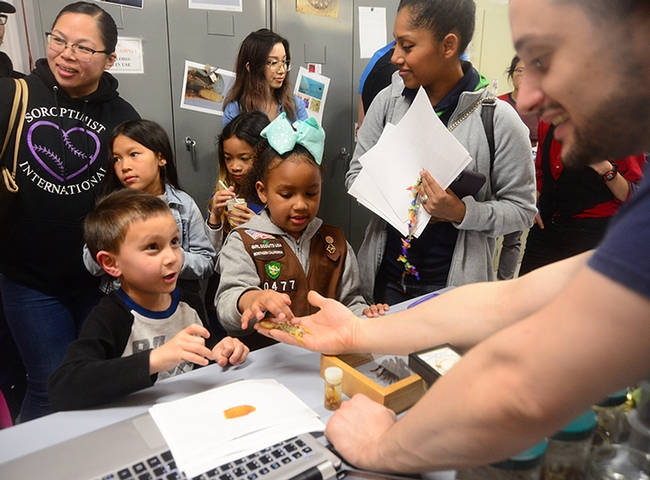
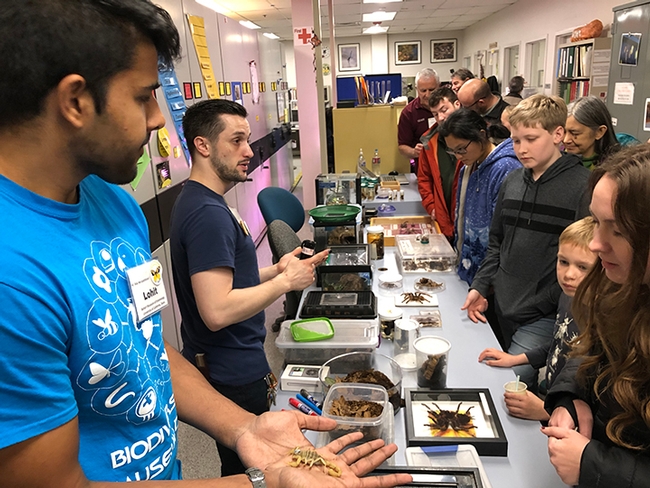
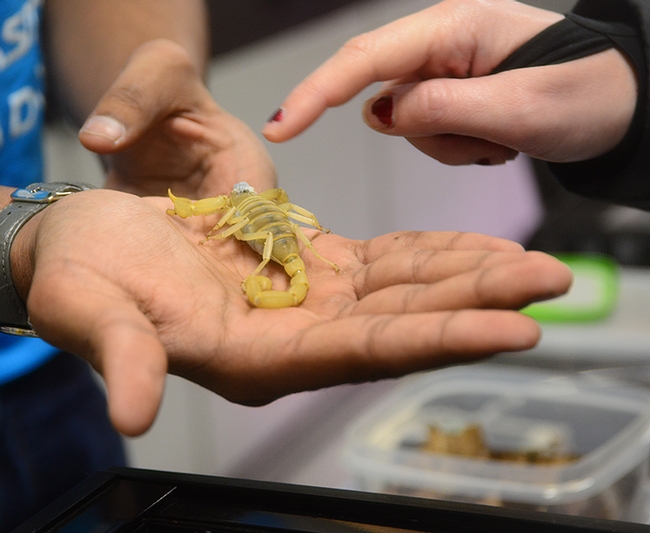
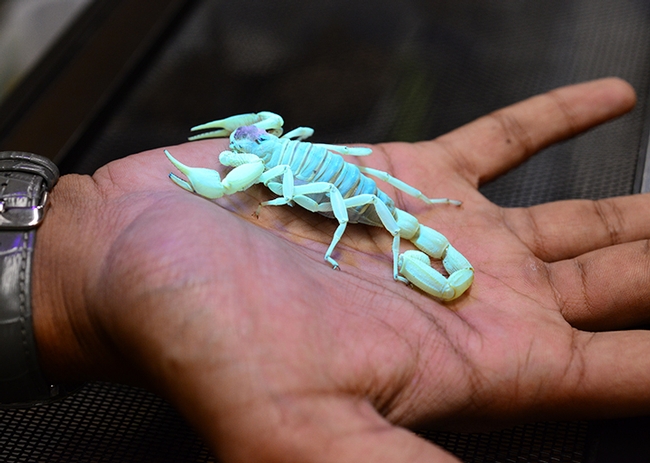
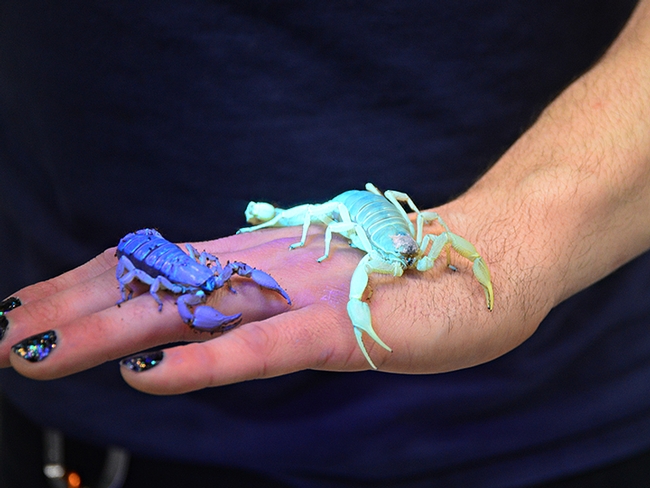
- Author: Kathy Keatley Garvey
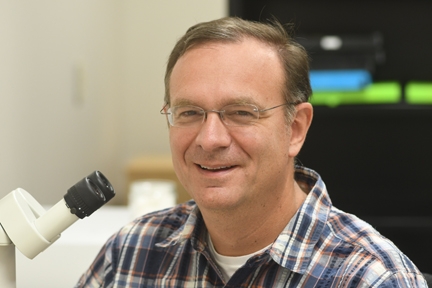
Spiders--especially jumping spiders, crab spiders and orb weavers--fascinate me. They've been around for 400 million years and are cunning, skillful predators. I don't relish them eating a honey bee in our pollinator garden, but everything has to eat. If I were in charge of their culinary habits, though, I'd point them in the general direction of a delicious stink bug or a scrumptious green bottle fly or a tasty lygus bug. And ask them, pretty please, to leave my honey bees alone.
Still, many people fear spiders. Arachnophobia is a common phobia, but there are five good reasons to like spiders, according to Jason Bond of the UC Davis Department of Entomology and Nematology.
The five good reasons to like spiders?
- Spiders consume 400-800 million tons of prey, mostly insects, each year. Humans consume somewhere around 400 million tons of meat and fish each year.
- Spider silk is one of the strongest naturally occurring materials. Spider silk is stronger than steel, stronger and more stretchy than Kevlar; a pencil thick strand of spider silk could be used to stop a Boeing 747 in flight.
- Some spiders are incredibly fast – able to run up to 70 body lengths per second (10X faster than Usain Bolt).
- Athough nearly all 47,000-plus spider species have venom used to kill their insect prey, very few actually have venom that is harmful to humans.
- Some spiders are really good parents –wolf spider moms carry their young on their backs until they are ready to strike out on their own; female trapdoor spiders keep their broods safe inside their burrows often longer than one year, and some female jumping spiders even nurse their spiderlings with a protein rich substance comparable to milk.
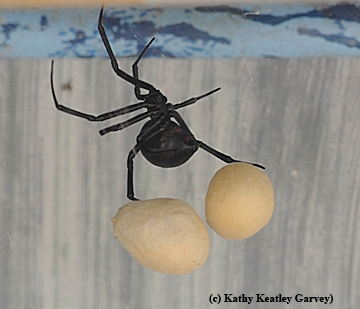
Following his presentation, activity stations will be open in the Bohart Museum where visitors can “Assemble an Arachnid,” “Create a Chelicerate,” “Cribellate vs. Ecribellate Silk,” “Catch a Moth,” “Eat Like a Spider,” and learn about "Spider Senses" and “Trapdoor Specifics.”
Visitors will see live specimens and specimens in alcohol. They'll learn the differences between woolly silk and sticky silk. They'll see the Bohart arachnids--tarantulas--and hold some of the non-arachnids, including walking sticks and Madagascar hissing cockroaches.
“Spiders are an incredibly diverse group with more than 50,000 species described with probably another 200,000 remaining to yet be discovered,” says Bond, who joined the department last July from Auburn University, Alabama. “They are quite ancient, with fossils dating back well over 300 million years and are known to be exclusively predatory.”
Bond joined the UC Davis faculty after a seven-year academic career at Auburn University, Ala. He served as professor of biology and chair of the Department of Biological Sciences from January 2016 to July 2018, and as curator of arachnids and myriapods (centipedes, millipedes, and related animals) at the Auburn University Museum of Natural History, from August 2011 to July 2018.
The Bohart Museum of Entomology, directed by Lynn Kimsey, professor of entomology at UC Davis, houses nearly eight million insect specimens collected from all over the world. It also includes a gift shop and a live “petting zoo,” comprised of Madagascar hissing cockroaches, stick insects and tarantulas.
